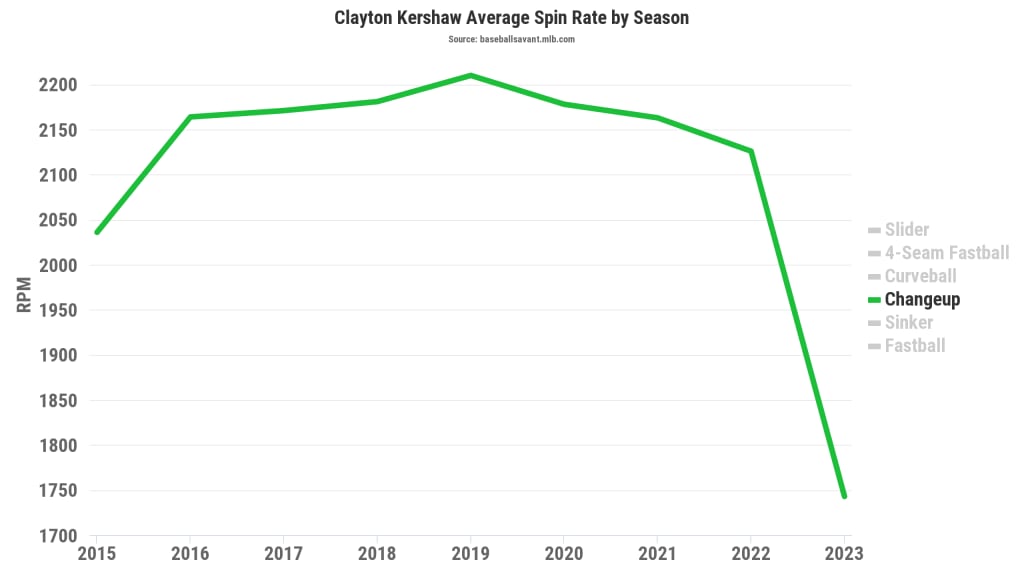It's Clayton Kershaw's new version of an old trick.
In his 15th season, the Dodgers' longtime ace is throwing a split-change, replacing the traditional changeup that he could never quite get to work over the years.
Kershaw's new pitch type is a changeup thrown with a splitter grip: The index and middle fingers spread in a "V" shape around the seams of the baseball, rather than the traditional circle change, where the thumb and index finger form a circle on the inside of the baseball.
For the southpaw, the impact of switching to a split-change isn't earth-shattering. Kershaw has been throwing the split-change since February, and working on it all year, but he uses it sparingly in games, just like his changeup. He's thrown it 30 times this season, accounting for 1.6% of his total pitches. Kershaw will throw, at most, a handful of split-changes per start.
Thirty changeups out of nearly 2,000 pitches thrown might seem trivial. Kershaw himself seems to think so, joking that, "It's not worth talking about." But 30 changeups is also the most he's thrown in a single season in a full decade.
And Kershaw hasn't done this before. When a future Hall of Famer makes a change to a repertoire that's been one of the steadiest in baseball for a long time -- Kershaw's ever-dependable fastball-slider-curveball trio -- it's worth taking a look at.
So … Why throw the split-change now?
"It's just because I'm tired of trying to pronate," Kershaw said. "I just can't pronate. Every year I work on it, and it doesn't get any better, so I was like, 'Well. Let's try something a little different.'"
Pronation is the way a pitcher's hand and forearm twist down and inward when they throw a changeup. (Rotating in the opposite direction, outward and around the baseball like on a curveball, is supination.) But a split-change doesn't require the same degree of pronation as a traditional circle change. Kershaw can deliver the splitter with a truer, over-the-top release, like his fastball.
"I don't go that way," Kershaw quipped, demonstrating with his left arm the pronated release of the changeup that's never responded the way he wants. "So splitting your fingers makes it slow down a little bit, and hopefully gets a little movement."
Kershaw wants to let his grip do the work, rather than have to generate the movement and velo differential himself through a mechanical action that's unnatural to him.
With a split-change, the pitcher's wide grip outside the seams takes the velocity off the pitch to get the speed of a normal changeup, while it also creates the tumbling vertical drop of a splitter.
"I try to get just off the seams [with the grip]," Kershaw said. "Just to kill the spin a little bit."
You can see the difference between Kershaw's split-change and his old changeup in the Statcast data. It's small, but it's there.
The split-change has a significantly lower spin rate than his traditional changeup. That's a good basic characteristic for an offspeed pitch like a split-change to have; it's what Kershaw wants.
Kershaw's changeup spin rate by season, Statcast era
2015 -- 2,036 rpm
2016 -- 2,164 rpm
2017 -- 2,171 rpm
2018 -- 2,181 rpm
2019 -- 2,210 rpm
2020 -- 2,179 rpm
2021 -- 2,163 rpm
2022 -- 2,126 rpm
2023 (split-change) -- 1,743 rpm

That low spin allows Kershaw to generate more downward movement than he used to, without having to throw the pitch slower.
Kershaw's split-change has averaged 84.8 mph this season, a mph harder than the 83.8 mph his old changeup averaged in 2022. But it's also dropping the same amount on its way to the plate -- 23.3 inches -- which is as much drop as it's ever had since Statcast started tracking. In other words: The split-change is, like Kershaw hoped it would, inducing more vertical movement than his old changeup.
"If I throw it right, it actually does what it's supposed to do," Kershaw said, comparing his split-change to his traditional changeup, which, on top of it not being the quality pitch he wanted it to be, he also always struggled to locate. "And it's a little bit easier for me. Not command, yet. But easier to throw, for sure."

Kershaw has even done something with the split-change that he hadn't in his last four years of throwing a traditional changeup: strike out a batter with it.
The splitter as a pitch type is more popular than ever in MLB, with usage league-wide at an all-time high for the pitch-tracking era, which goes back to Kershaw's rookie year, 2008. Kershaw's split-change isn't a full splitter -- he said throwing a splitter isn't easy on the elbow -- but it's in the same family. His split-change is a compromise, not gripped as aggressively as a splitter, but close enough to get some of the pitch's positive effects.
"You're scared of your elbow with the split, but I don't really split it that much," Kershaw said. "And I'm not gonna throw it a lot. So give it a shot, and hopefully I can get a little more consistent with it."
Kershaw has never needed a changeup. Really, he still doesn't need it -- his three-pitch mix is still one of the most effective arsenals in baseball.
So the split-change probably won't factor prominently into Kershaw's postseason outings for the NL West champs: He hasn't thrown a changeup in a playoff game since 2017, and the only other year he threw it in October was 2013. He's pitched in nine different postseasons without using a changeup at all.
But who knows -- maybe Kershaw will break off a split-change at the perfect time in 2023, to a hitter who least expects it, and it will work the way his changeup didn't.
